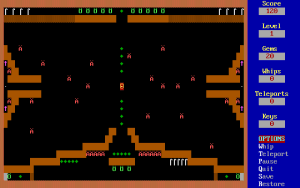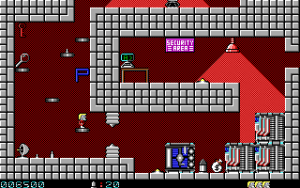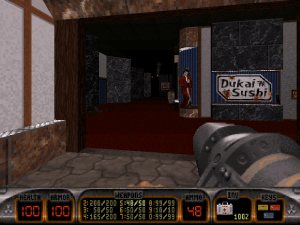- Qualcomm Launches Snapdragon 4 Gen 2 Mobile Platform
- AMD Launches Ryzen PRO 7000 Series Mobile & Desktop Platform
- Intel Launches Sleek Single-Slot Arc Pro A60 Workstation Graphics Card
- NVIDIA Announces Latest Ada Lovelace Additions: GeForce RTX 4060 Ti & RTX 4060
- Maxon Redshift With AMD Radeon GPU Rendering Support Now Available
Remembering Apogee & 3D Realms

The news of 3D Realms demise hit the Internet like a ton of bricks last week, and to say it’s disappointing would be a major understatement. As a developer that’s been around for over 20 years, they have a lot to boast about today. Read on as we take a stroll down memory lane, and see just what it was that made Apogee so innovative and unique.
Page 1 – Introduction, Apogee’s History
When reading through my RSS feeds each morning, it’s rare that a post will jump right out at me, but that was certainly the case when I read the terms, “Duke Nukem” and “Shuts Down” in the same title. I immediately shrugged it off as some vicious rumor, but as the day progressed, it became increasingly obvious that it wasn’t a marketing ploy, nor a joke. One of the most legendary game developers was indeed shutting down, 3D Realms.
As a big fan of the company, this realisation hit hard, and even now I hate to acknowledge the fact that it’s true. I’m not alone, as 3D Realms’ official forums have made obvious. Upon learning of the news, people bombarded their poor server in a state of shock, disappointment and uncertainty. And despite long-term team member Joe Siegler’s assurance that there was no joke, many people refused to believe.
In today’s game industry, the name 3D Realms isn’t well-known when compared to developers like Rockstar, EA, or Ubisoft, but the company has been around much longer than most (founded in 1987), and have some real classics under their belt. They didn’t have an active release schedule either, releasing new games sporadically in recent years. Despite that, the company managed to retain their Independence as a private company, so in a way, it’s impressive that they lasted as long as they have.
Apogee’s and 3D Realms’ Brief History
If you’ve been gaming on the PC for many years, as in 15 – 20, then you may be more familiar with 3D Realms’ legal name, Apogee Software. Founded in 1987 by Scott Miller, the first game to see a release was his own title, Kingdom of Kroz, an EGA-colored game that utilized ASCII characters for the character, enemies, and other objects. It sold so well, that the company had enough financial backing to begin growing, and also bring new team members on board.
Four years after the company’s founding, the outspoken George Broussard joined ship, bringing with him a few personally-developed games that were previously released under his own company, Micro/FX. Such titles included Pharaoh’s Tomb and Trivia Whiz. He has remained with the company up until the end, and often partook in forum activity on certain gaming sites to talk directly to the fans. As the co-creator of the Duke Nukem series, you can say that many gamers have a lot to thank him for.
 Duke Nukem I |
 Duke Nukem II |
Throughout the years, Apogee didn’t only act as a developer, but also a publisher. Within the first ten years of the company’s introduction, classics such as Commander Keen, Paganitzu, Wolfenstein 3D, Alien Carnage (aka Halloween Harry), Mystic Towers, Hocus Pocus and Wacky Wheels were released. Of course, it’s the self-developed games that stick out in my mind the most, which include Duke Nukem 1 and 2, and also Cosmo’s Cosmic Adventure, Bio Menace, Rise of the Triad, Major Stryker, Crystal Caves and many more.
 Kingdom of Kroz |
 Cosmo’s Cosmic Adventure |
 Bio Menace |
 Crystal Caves |
 Rise of the Triad |
 Secret Agent |
Although Apogee carries a few innovations under their belt, the most notable might be their contribution to the shareware scheme for games. Back in these days, it wasn’t uncommon for one game to span various episodes… take Commander Keen or Duke Nukem I and II for example. So, their idea was simple. Give the first episode to the consumer for free, and if they like what they see, then hopefully they’ll follow through with a purchase of the complete game.
Although trialware like this is popular today, the idea back then was interesting and unique, and almost all Apogee games that spanned multiple episodes offered this ability. In the two examples below, you can see exactly how things went down. If you wanted to purchase the game, you simply had to make out a cheque for the correct amount, include specifics (such as disk size or monitor type), mail it in and wait for the diskettes. I’m sure I’m not alone in saying that I’m glad this isn’t how things work today!
As time passed and 3D games began catching on, Apogee saw an opportunity to add a second developer name to their inventory, which, quite appropriately named, was 3D Realms. The goal was to keep 3D games to that label, while restricting 2D games to the Apogee name, as a way to properly target whatever title they were publishing. As time went on though, especially nearer the turn of the century, Apogee realized that the demand for 2D games was low, and from 1996 onward, the Apogee name was no longer used.
It’s also worth noting that a third label was introduced in 1998, Pinball Wizards. This was used only for one game, however, Balls of Steel, after which point it also was discontinued.
After 3D Realms’ introduction in 1994, the first game to see a release was Terminal Velocity, developed by Terminal Reality. This Descent-like game was a great start for the new brand, and really helped distinguish 3D Realms from Apogee. The most important game that 3D Realms ever developed and published came the following year: Duke Nukem 3D. If you happened to be a PC gamer in 1996, there’s little doubt you spent some good time with this one.
As this time, 3D shooters weren’t uncommon, far from it. But Duke was different. He brought all of what made the original two games great, but introduced great voice acting (and a snarky attitude), fun level design, outrageous weapons and some of the most bad ass monsters ever to grace your 25lbs SVGA monitor. Oh, and let’s not forget about the large helping of controversy.
Yes, Duke Nukem 3D had it all, and if you were under 15-years-old, like I was, chances are you didn’t exactly jump at the opportunity to show the game off to your folks. There was something about “Sister Act III” posters, strippers and steroids use that I figured my mother wouldn’t like, so I was wise to not take a chance. Little did I realize upon first loading the game on my 500MB hard drive, that I was about to lose hundreds of gameplay hours to it and its never-ending mod and map releases.
 |
 |
 |
 |
Even today, the game hasn’t lost its charm, and I recently went through the entire thing again on the Xbox Live Arcade. It’s certainly dated, but everything about the game that made it great, still makes it great. Plus, it’s a game that’s still actively-supported, and with such products as the High-Resolution Pack and other mods, the game will likely still be enjoyed many years from now.
Of course, while Duke Nukem 3D is one title that’s actively associated with 3D Realms, the company also published a few titles, even recent ones, that you’ve likely played. Aside from other Duke Nukem titles, these include Max Payne 1 and 2 (the latter of which I consider to be a masterpiece) and also Prey, the mind-warping first-person shooter from Human Head Studios.
Support our efforts! With ad revenue at an all-time low for written websites, we're relying more than ever on reader support to help us continue putting so much effort into this type of content. You can support us by becoming a Patron, or by using our Amazon shopping affiliate links listed through our articles. Thanks for your support!







